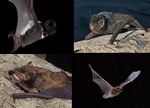Bats of Western - Integrate Sustainability
←
→
Page content transcription
If your browser does not render page correctly, please read the page content below
Integrate Sustainability 10 July 2020
Environment
Bats of Western
Rafael Louzeiro – GIS Environmental Specialist
Bats are so unique in nature that a particular category was created for them in the
order of mammals, called “Chiropterans”, which means "winged hands". Bats
constitute around 20% of all mammals in the world (Treehugger 2019), and they are
the only ones capable of real and sustained flight. Scientists divide bats into two sub
orders due to their size, the Mega bats, for example, Flying Foxes (Pteropus
poliocephalus) and the Micro-bats such as Gould’s Wattled Bats (Chalinolobus
gouldii).
Figure 1 – Flying-fox. (Earthly Facts 2019) Figure 2 - Gould’s Wattled Bat (Photo: © T Hodge).
You may or may not have noticed that in Western Australia bats are found in most of
the areas of the state, however, widespread habitat loss and fragmentation has led to
an increase in urban and rural bat populations. Bats are important for the ecosystem
as they provide numerous ecosystem functions, such as pollinating trees, spreading
seeds and consuming millions of insects every night. Summary/Quote
Figure 3 - Bat eating insect Figure 4 - A rescued orphan feeds on eucalyptus pollen.
(Bat Conservation International 2015). (CREDIT:DOUG GIMESY / ALAMY)
Bats are vital for the maintenance of biodiversity, they pollinate through flower to
flower contact and the dispersal of seeds through their guano (bat poo). The majority Bats are important for the
of bats are herbivores, which feed on vegetables and seeds. Some bats are ecosystem as they provide
Nectarivores meaning they prefer flower nectar and pollen as their main food source. numerous ecosystem functions,
The insectivores eat, you guessed it, insects, while the majority of bats from around such as pollinating trees,
spreading seeds and consuming
the world eat fruit, making them frugivorous.
millions of insects every night.
It is worth noting that among the thousands of bat species, only three are
hematophagous, meaning they feed on the blood of birds and small rodents. They are
the “common vampire bat” Desmodus rotundus, the “white-winged vampire bat”
Diaemus youngi, and the “hairy-legged vampire bat” Diphylla ecaudata. It is these
bats that have probably caused a
bad reputation for the species,
possibly being one of the reasons
for bats being a threatened species.
Figure 6 - Hematophagous bats. (sudonull 2020)That some bats make “low-flying flights”, this may feel like a threat but there are two very good reasons for this.
The first is that “fruit bats” fly above and below the plants they intend to feed on, the second reason is that these
animals fly towards objects to locate them on their radar (echolocation) and see if it represents a threat, this
includes humans and animals. Instinctively bats hide when an “intruder” appears in their natural environment.
Figure 5 - Bats using the radar to identify a prey. (Friends of Forrestdale 2013)
Unfortunately, many types of bat are now under threat, with 15.8% of
species classified as endangered or extinct (Coleman, K. 2018). In addition
to the persecution driven by fear and ignorance, other factors have
decreased the number of bats such as, habitat destruction, fire, pesticides,
feral animals and disturbance at caves. In Northern WA, for example,
goannas and python may be partial to a bat or owls and other raptors that
may try to prey on a flying fox. In the urban environment, such as Perth, it
is more likely ravens that will try to snatch a newborn. Urban
environment predators, the cat and dogs.
Figure 7 - Some of the main bat predators in
Although bats are under threat, there are vast and diverse bat Western Australia. (Museum 2019)
communities in Western Australia. The state supports a total of 37
species from seven families, two of which are endemic to Western Australia (Armstrong 2018).
The most common type of Bat in WA is the microbat, specially the
Gould’s Wattled Bat, which is highly adaptable, found over most of
Australia and uses a variety of roosting sites including tree hollows.
The Whitestriped Freetail Bat is endemic to southwest WA and is
one of the few bats whose echolocation calls are audible to the
human ear. The least common in the Perth area is the fast-flying
Western False Pipistrelle, which is also endemic to southwest WA
(Friends of Forrestdale 2013).
According to the Department of Health Western Australia
(healthywa.wa.gov.au), Bats can carry on some disease and risk.
Figure 8 – a) Whitestriped Freetail Bat, b) Gould’s Wattled Bat, c) Similar to other wildlife, bats
Falsistrellus mackenziei and d) Vespadelus douglasorum. (Litjens
2016) and (Museum 2019) can carry bacteria and
viruses, including the
Australian Bat Lyssavirus (ABLV), Hendra virus, Histoplasmosis,
Leptospirosis and Salmonella. There have been very few documented
cases bats to human infections transfer. The risk of infection can be
managed by limiting direct handling and making sure you wear puncture-
proof gloves, long sleeves and protective glasses if ever having to handle
bats. The best way to avoid any contact with bats is by using protective
equipment, clothes and tools, so you do not need to touch the animal
directly. Figure 9 - Examples of protective equipment,
clouths and tools.Bats can come across as intimidating or scary even. However, these little flying mammals are such unique,
misunderstood creatures that play a vital role in biodiversity. The best thing you can do to help the bats populations are:
• Planting native habitat trees or fruiting trees.
• Installing micro-bat nest boxes in trees, when possible.
• Learning more about bats.
• Raise awareness of the importance of bats.
Integrate Sustainability has experience in identify and managing Biodsiversity in WA. If you or your business needs
assistance please call Integrate Sustainability on 08 9468 0338 or email enquiries@integratesustainability.com.au
References
Armstrong, Kyle N. 2018. "The current status of bats in Western Australia." University Western Australia -
UWA Specialised Zoological; kyle.armstrong@graduate.uwa.edu.au.
Integrate Sustainability
Bat Conservation International. 2015. Green news from the UC Division of Agriculture and Natural
Primary Business Address Resources Bats in the belfry? No, bats in walnut orchards. 04 15. Accessed 06 20, 2020. https://ucanr.edu/
Lower Ground Floor blogs/blogcore/postdetail.cfm?postnum=17395.
3 Richardson St Burbidge, A.A, McKenzie, N.L., Brennan, K.E.C., Woinarski, J.C.Z., Dickman, C.R., Baynes, A., Gordon, G.,
West Perth, 6005 Menkhorst, P.W. and Robinson, A.C. 2007. "Conservation and status of Australia’s terrestrial mammals."
Western Australia Australian Journal of Zoology 56: 411–422.
Phone: (+618) 9468 0338 Coleman, K. . 2018. Bats of the Burnett Mary. Queensland: Burnett Mary Regional Group for Natural
E-mail: enquiries@integratesustainability.com.au Resource Management Ltd.
Digital Transformation Agency, Department of Communications and Arts, and CSIRO. 2014-2018.
NationalMap. Accessed 03 16, 2020. https://nationalmap.gov.au/about.html.
DigitalGlobe. 2020. https://www.digitalglobe.com/. Accessed 03 25, 2020.
Earthly Facts . 2019. Earthly Facts . September 29. Accessed 06 29, 2020. https://www.earthlyfacts.com/
grey-headed-flying-fox/.
Friends of Forrestdale. 2013. "The Amazing Life of Bats." Photos: Southern Forest Bat and Lesser Long-
eared Bat by Jesse Young;. 06 10. Accessed 06 19, 2020. http://www.sercul.org.au/wp-content/
uploads/2016/12/FOF_Bats.pdf.
Government of Western Australia. 2020. Department of Water and Environmental Regulation. Accessed
03 26, 2020. https://www.water.wa.gov.au/maps-and-data/monitoring.
Litjens, Nathan. 2016. flicker. September 15. Accessed 06 29, 2020. https://www.flickr.com/
photos/126002448@N02/40622825710/in/photostream/.
Museum, The Australian. 2019. Copyright © 2020 The Australian Museum. 03 18. Accessed 06 29, 2020.
https://australian.museum/learn/animals/bats/western-false-pipistrelle/.
sudonull. 2020. sudonull. Accessed 06 29, 2020. https://sudonull.com/post/3047-Bloody-Kiss-
Vazorelaxation-Properties-of-Vampire-Bat-Saliva.
The Atlas of Living Australia. 2019. The Atlas of Living Australia - Occurrence records map (271 records).
Accessed 09 12, 2019. https://bie.ala.org.au/species/urn:lsid:biodiversity.org.au:afd.taxon:36b436b1-
3dc2-487d-8386-8bf3f3972e40.
Treehugger. 2019. 13 Images and Facts About Misunderstood Bats. October. https://
www.treehugger.com/bat-pictures-images-and-facts-about-a-misunderstood-creature-4864066.You can also read



























































